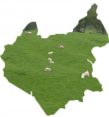Eaton is a village in North West Leicestershire, near Grantham and Melton Mowbray. The main denomination of non-conformity was Methodism, which included Wesleyan, Primitive and Wesleyan Reform Methodists. The earliest of these, Wesleyan Methodists, arrived in the early 1820s. There is also evidence of Congregationalists. However, the documentation for all of these branches of non-conformity is not significant.
Wesleyan Methodists
A chapel belonging to Wesleyan Methodists was built in 1823. It contained 130 sittings (of which 80 were free) as well as 20 standing spaces.[1] However, there is no mention of Methodists on the 1829 return of meeting houses.[2] On the 1851 Religious Census, the congregation size was recorded as 97 and 120 for services held in the morning and evening respectively. Sunday School attendance was noted at 49 for both. Average attendance at church and Sunday School were recorded at 77 and 49 respectively, both being marked only in the morning.[3]
In about 1896, John and George Manchester, brothers who had been born in Eaton but who had emigrated to New Zealand, visited the village and promised to give £100 towards a new Wesleyan hapel if the Eaton Methodists could provide a similar sum. A 99-year lease on a site in the village was taken from the Marquis of Granby in 1906 and a building contract was agreed with Parks, of Grantham. A chapel for 160 worshippers was built, with a separate Sunday School to accommodate 100, which adjoined the chapel and was set at a right-angle to it.[4]
Primitive Methodists
The only record of Primitive Methodists is on the 1851 Religious Census. This noted that they met in a dwelling house, which was, however, used exclusively for worship. Attendance on census day was noted at 31 and 66 for afternoon and evening services respectively –although only 40 sittings were noted, all of them free. The average attendance was given at 50, for a morning service.[5]
Wesleyan Reformed Methodists
A separate Wesleyan reformed congregation formed in 1851, meeting in a house. They erected a meeting house in later that year, which was described simply as a ‘wooden building’.[6] On the 1851 Religious Census, the congregation recorded was 30 and 40 at afternoon and evening services respectively. The average congregation was recorded at 30 for each.[7]
Congregationalists
The only evidence of Congregationalists in the village comes from a directory in 1881, which noted only that they had a place of worship.[8]
[1] White, Hist. Gaz. & Dir. Leics. (Sheffield, 1846) p. 234; 1851 Religious Census, entry for Eaton, Wesleyan Methodists, HO 129/418/69.
[2] 1829 Return of Religious Houses.
[3] 1851 Religious Census, HO 129/418/69.
[4] Grantham Journal, 6 October 1906
[5] 1851 Religious Census, entry for Primitive Methodists, HO 129/418/71.
[6] White, Hist. Gaz. & Dir. Leics. (Sheffield, 1863) p. 716
[7] 1851 Religious Census, entry for Wesleyan Reform Methodists, HO 129/418/70.
[8] Kelly’s Dir. (1881) p. 517.
